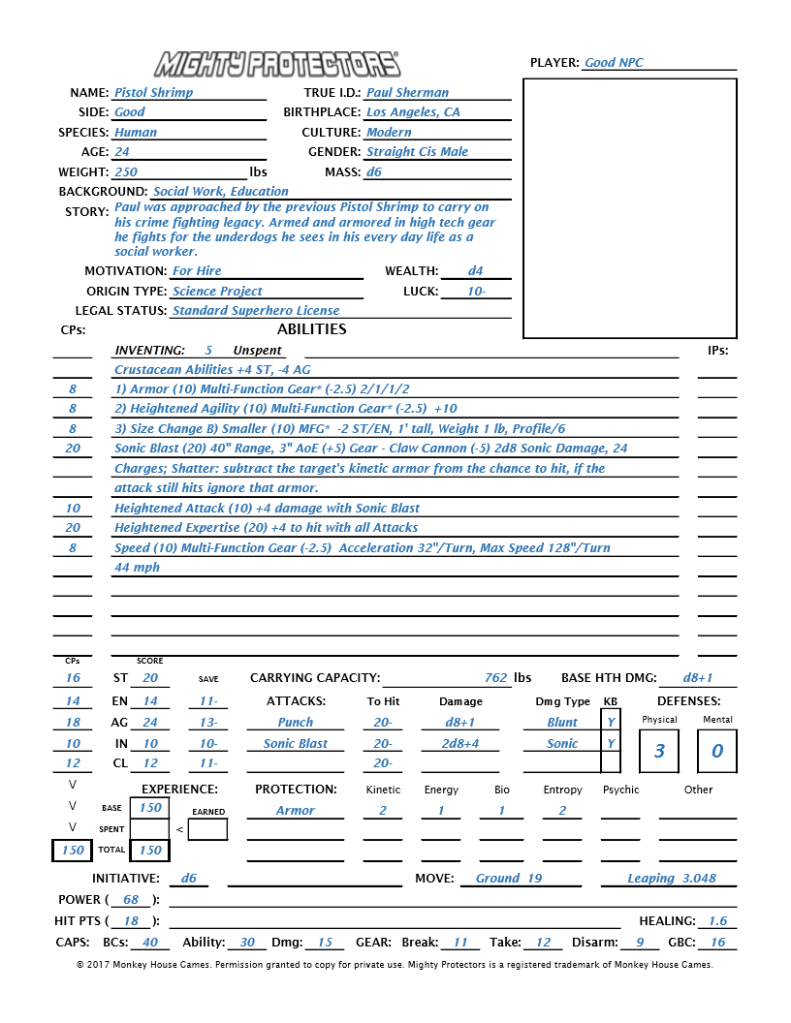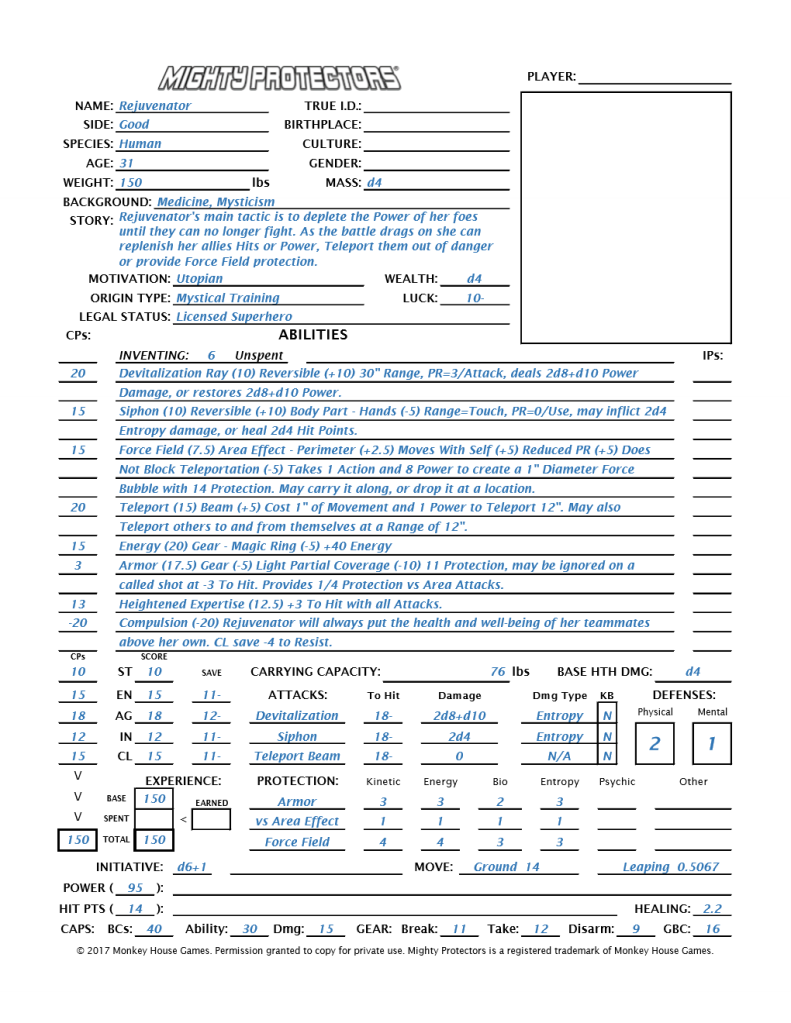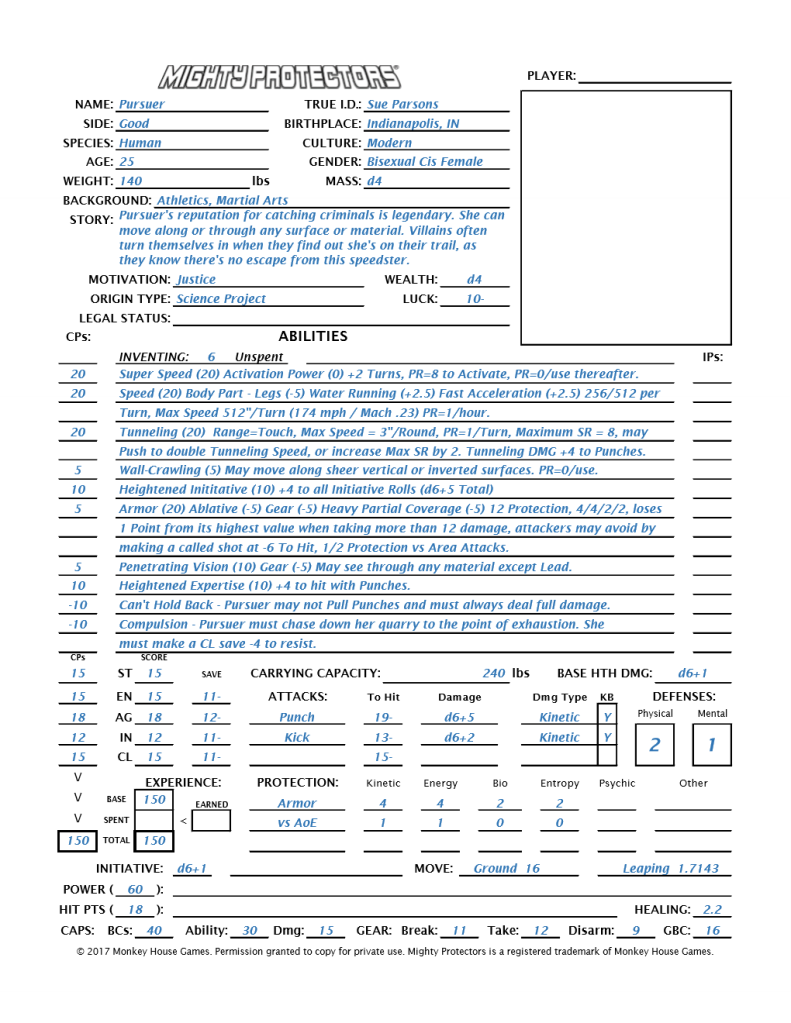This is the first of a series of articles for V&V 3.0
focusing on specific archetypal character builds or roles. While V&V has no
class roles, that doesn’t stop people from wanting to play Tanks, Healers, DPS,
Support, Controllers, Speedsters, etc. This desire might come from the comfort
and familiarity that other TTRPGs character classes offer, or it could come
from the original inspiration for superhero RPGs themselves—the comic books
that introduced us to the genre. No matter where it comes from, it’s worth
nurturing because it helps flesh out the identity and motivation of a player’s hero
and helps to get them into character. Since it’s not entirely obvious how to
mimic all the classic class roles using V&V, I’ll outline some system
specific ways we can accomplish our goal.
Enter, the Tank:
When most players think of a Tank, they imagine her being
durable—able to take a ton of punishment for her teammates. The problem with
TTRPGs is that you will need to force enemies to attack your Tank. If you’re
extremely tough, then they will likely turn their attention to softer targets.
That’s why every great Tank has a Taunt—an ability that forces enemies to focus
on them. In V&V, that ability is Emotion Control.
Emotion Control is a Psychic Save Attack. In V&V terms,
this means that targets hit by it get to roll to resist its effects. In TTRPGs
this is commonly known as a Save, Saving Throw, or Save Roll. As this will be
the ability that defines our Tank build, we need to make sure it hits, and that
the target fails their Save. We can do that with other Abilities like
Heightened Expertise to gain a bonus To Hit with Emotion Control, and Willpower
C) Self-Control which will allow you to Push to impose a greater Save Penalty
on your target. Self-Control is also a handy ability in a pinch allowing you to
run faster, lift more, and hit harder. Sounds like a great Tank power!
So, we have Emotion Control, Heightened Expertise, and
Willpower C) Self-Control. There are many ways to go from here, but now that we
have our utility abilities out of the way, we should focus on defensive and
offensive abilities. V&V smartly suggest that all characters roll or choose
two offensive abilities, two defensive abilities, and two miscellaneous
abilities. This makes your hero well rounded—able to deal damage, survive, and
perform some other useful tasks. There are dozens of abilities to choose from,
but I’m going to narrow it down into three styles of Tanking—the Evasive Tank, Thorn
Tank, and The Brick. Let’s start with the Defensive Abilities.
The Evasive Tank aims to avoid being hit. Some useful
Abilities for an Evasive Tank are: Glare, Heightened Agility, Heightened
Defense, Invulnerability, Non-Corporealness, and Teleportation. The Thorn Tank
uses Ability Fields to deal damage back to their attackers when they are hit.
Useful Abilities for Thorn Tanks are: Chemical Body, Disintegration Field,
Electrical Field, Flame Aura, and Reflection. While the first two types of
Tanks can be fun and interactive, I’ll be building The Brick. What can I say, I
like the classics. Useful Abilities for The Brick are: Absorption, Armor,
Density Change, Durability, Energy, Force Field, Heightened Endurance,
Invulnerability, Regeneration, Shield, and Stretching Abilities.
I’m going to go with Armor and Heightened Endurance. Armor provides a flat damage reduction against the most common types of attacks, while Heightened Endurance gives our Hit Points a nice boost while also adding a hefty chunk to our Power score which we’ll need to fuel our Emotion Control, Willpower, Pushing, and to Roll With damage. Now on to our Offensive Abilities. It is very likely that the targets we have goaded into attacking us have some way to attack us from range. Therefore, I’m skipping making a list and I’m going straight for a longtime V&V staple—Power Blast. Its Power cost is low, and it deals respectable damage. Wait. What? You want to punch things? Some useful Close Combat Offensive Abilities for The Brick are: Heightened Expertise, Heightened Attack, Natural Weaponry, Poison, Siphon, and Stretching Abilities. Actually—now that I think of it, Stretching Abilities offers some great utility and defense, while allowing you to punch things at range. Ok—new plan! We’re going with Natural Weaponry and Stretching Abilities, and we’re ditching Armor. This Brick malleable! Let’s look at our creation so far, keeping in mind this is a Standard Power Level hero. That’s 150 CPs (Character Points), eighty of which will go into our Abilities, while the remaining 70 will go into our BCs.
Emotion Control
Heightened Endurance
Heightened Expertise
Natural Weaponry
Stretching Abilities – Elongation, Oozing, Plasticity
Willpower C) Self-Control
I’ve used bold text to indicate which of our Abilities are
our Core Abilities. In V&V a new character may have up to four Core
Abilities which may start at 10, 20, or 30 CPs for Low, Standard, and
High Power Level characters respectively.
The other Abilities must have less than 20 CPs allotted to them. To get
some points back, and add some flavor to our hero, we’ll be adding some
Weaknesses:
Can’t Feel Pain – “Pain don’t hurt” –Dalton
Compulsion – Our Brick must always challenge the toughest
enemy and may not flee.
After some creative use of modifiers and tweaking of numbers
and stats, I give you…
THE PLIABLE MAN!

Gaze at his gelatinous glory. To shave some points from his Emotion Control I applied the “Single Emotion” and “Requires Speech” modifiers. I feel like every good Tank should have to shout to get their opponents’ attentions, and he only needs to focus on one emotion, rather than a broad spectrum. After all, he just needs to make enemies focus on himself. As you can see, he has plenty of Power and Hit points, increased accuracy with his Emotion Control and melee attacks, and the ability to punch targets up to 6” (30 feet) away! He has the added utility of being able to ooze through small cracks, and his Plasticity gives him a whopping 9 Kinetic Protection! Finally, his Willpower lets him Push for a -4 to a target’s Save, +4 to his own Saves, +4 damage, x4 Carrying Capacity, or x4 Movement Rate. On the downside, it costs 4 Power, so use it sparingly.
Our Tank is complete. He has a Taunt, he’s extremely
durable, and he’s a capable fighter with some added utility. I hope you enjoyed
this character build article. Please check back as I will be creating more,
specifically: The Blaster, the Controller, the Support, the Speedster, and the
Infiltrator.
 Fabri-Kate, mistress of fabrication–naturally.
Fabri-Kate, mistress of fabrication–naturally.
 The Pistol Shrimp, protector of the vulnerable.
The Pistol Shrimp, protector of the vulnerable.
 The Geminator
The Geminator





